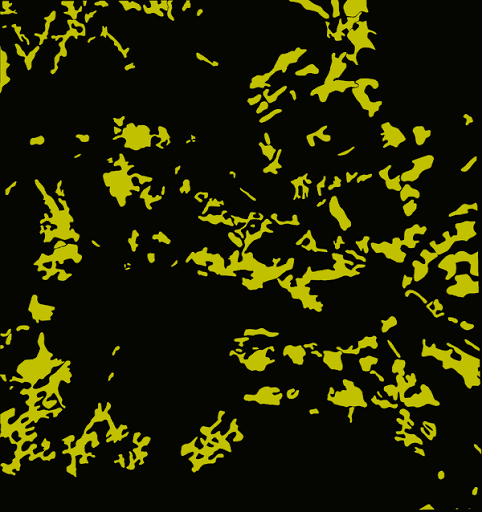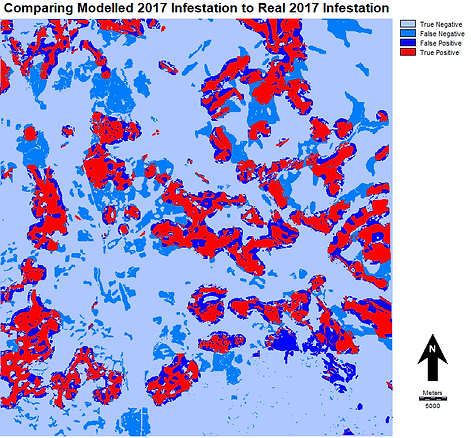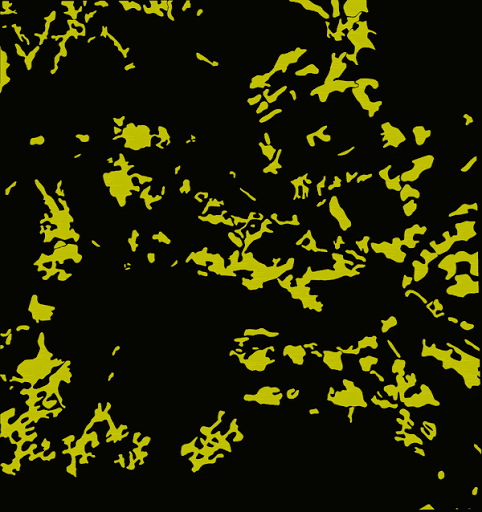Investigating Spruce Beetle Propagation using Cellular Automata

Background
This project attempts to forecast how spruce beetle would propagate through a heavily forested area of the Omineca region in British Columbia, Canada.
Much like the mountain pine beetle, the spruce beetle attacks the inner bark of the tree eventually killing it in about a year when its larvae hatch. When its population numbers are high the spruce beetle has the potential to cover large areas where mature spruce stands grow. The loss of these stands has irreversible impacts on the ecological system and causes a decrease in the diversity in habitats that rely on these trees. Moreover, the decrease in valuable timber due to the destruction of these forests can have a profound effect on the forest industry, from which the local and provincial economy depend heavily on.
The current infestation in the Omineca region is significant. In 2017 spruce beetles have been found to have impacted 340,000 ha making it the largest spruce beetle outbreak ever recorded in that region at that time.
Area: 5018 km2
Location: 54.64, -122.45 (85km NW of Prince George)
Spatial resolution: 30m
Projected coordinate system : NAD 83 UTM Zone 10N
Software: Esri ArcGIS (Processing), IDRISI Terrset (Model building)
Data


Figure 1: The study area chosen is outlined by the red square inside the Omineca Environment Region within British Columbia, Canada.
Cellular Automata Modelling
For this study, Cellular Automata (CA) is applied to model propagation of Spruce beetle infestation. Firstly, by applying inputs and constraints, we created a Multi criteria evaluation (MCE) suitability map which shows us areas most susceptible to infestation. We can then apply transition rules to the suitability map to see change/growth over time.
CA modelling allows integration of multiple raster-based datasets to model complex geospatial processes and patterns that continually evolve over time. By creating this model, we can observe the epidemics patterns and aid forest management teams to mitigate the problem.
Results
Using our forecasted 2017 model output, we calibrated our model with the real 2017 infested areas in an effort to create a more representative model of the propagation process. This involved attempting to match the forecasted and real areas as best we could, by adjusting various model parameters. The result leads to a slow and somewhat patchy propagation forecast for 2017 and 2018. We compared our forecasted 2017 model output to the real 2017 data using the Kappa Index of Agreement which gives us a value of 0.58, or a moderate level of agreement when only considering how the infected areas compare. We can then validate our model to compare our results to the original data collected.



Figure 5: Displayed is an animation of pine beetle propagation as the model forecasts where the infected areas spread to from 2016 to 2017 and 2017 to 2018.
Figure 6: Mapped in red are the areas where the 2017 model results and 2017 real data agree, while those in mid and darker blue are where the model failed to forecast real 2017 infected areas.
Scenarios
1. Wind
The velocity of a moving spruce beetle can be heavily influenced by wind direction. Therefore, by changing our original 67x67 filter to favor propagation in a north-west direction we can simulate the movement of spruce beetles due to prevailing South-Easterly wind.
2. Temperature
Average winter temperatures can control population growth by determining the number of spruce beetles that will survive the winter and live to reproduce. We simulated a mild and cold winter by modifying the propagation rate of our model, specifically the number of cells required to be infected in the neighborhood for the central cell to change. The simulation of a mild winter showed our forecasted propagation extending beyond our normal model, while the simulation of a cold winter showed the propagation to be significantly constrained.



Figure 7: Propagation of pine beetle infestation from 2016 to 2017 is displayed as if under the influence of a simulated prevailing South-Easterly wind over the course of 1 year.
Figure 8: The propagation extent of pine beetle was simulated through hypothetical winter scenarios where a mild winter will result in increase propagation potential and a coid winter will result in decrease propagation potential.
Conclusion
The infestation of the spruce beetle has caused significant environmental and economical impact in the Omineca region of British Columbia. This project attempts to forecast future spread of spruce beetle through the construction of a cellular automata model and use of multi-criteria techniques. Challenges exist when attempting to model complex systems that are influenced by factors occurring at both micro and macro spatial scales. Infestation propagation is subject to a degree of randomness when beetles are able to be spread across vast distances due to wind or human influences. Despite these challenges, application of CA modelling enables the visualization of these spatial-temporal phenomena and can provide a useful means to forecast future changes that will aide in decision making.
Project completed by Riley Smith in Fall 2019 for GEOG 452 Spatial Modelling at SFU, with assistance from peers P. Sarroca, J. Mugambi and N. Kimathi. Acknowledgments to teaching assistant Alysha Van Duynhoven and Dr. Suzana Dragicevic for helpful comments and direction.
References
-
Accumulative AOS in the Omineca Region - Data Catalogue. (2018, November 1). Retrieved October 23, 2019, from https://catalogue.data.gov.bc.ca/dataset/accumulative-aos-in-the-omineca-region
-
Byers, John A. "Wind-aided dispersal of simulated bark beetles flying through forests." Ecological Modelling 125.2-3 (2000): 231-243.
-
Data source: BC Data Catalogue: Aerial Overviews of Spruce Beetle Attack in the Omineca Region - Data Catalogue. (n.d.). Retrieved from https://catalogue.data.gov.bc.ca/dataset/aerial-overviews-of-spruce-beetle-attack-in-the-omineca-region
-
Dragicevic, S. (n.d.). More on IDRISI/TerrSet: MCE module. Burnaby.
-
Foster, A. C., J. K. Shuman, H. H. Shugart, and J. Negron. 2018. Modeling the interactive effects of spruce beetle infestation and climate on subalpine vegetation. Ecosphere 9(10):e02437. 10.1002/ecs2.2437
-
Hansen, E. M., & Bentz, B. J. (2003). Comparison of reproductive capacity among univoltine, semivoltine, and re-emerged parent spruce beetles (Coleoptera: Scolytidae). The Canadian Entomologist, 135(5), 697–712. doi: 10.4039/n02-109
-
Jenkins, M. J., Hebertson, E. G., & Munson, A. S. (2014). Spruce beetle biology, ecology, and management in the Rocky Mountains: an addendum to spruce beetle in the Rockies. Forests, 5(1), 21-71.
-
L. J. Corbett, P. Withey, V. A. Lantz, T. O. Ochuodho, The economic impact of the mountain pine beetle infestation in British Columbia: provincial estimates from a CGE analysis, Forestry: An International Journal of Forest Research, Volume 89, Issue 1, January 2016, Pages 100–105, https://doi.org/10.1093/forestry/cpv042
-
Ministry of Forests Lands and Natural Resource Operations. (2019, May 21). Omineca Spruce Beetle Outbreak. Retrieved November 19, 2019, from https://www2.gov.bc.ca/gov/content/industry/forestry/managing-our-forest-resources/forest-health/forest-pests/bark-beetles/spruce-beetle/omineca-spruce-beetle.
-
Perez, Liliana, and Suzana Dragicevic. "Landscape-level simulation of forest insect disturbance: Coupling swarm intelligent agents with GIS-based cellular automata model." Ecological modeling 231 (2012): 53-64.
-
Spruce Beetle Management in BC: Province of British Columbia - Forests, Lands & Natural Resource Operations. Retrieved from https://www2.gov.bc.ca/assets/gov/farming-natural-resources-and-industry/forestry/forest-health/bark-beetles/spruce_beetle_guidebook.pdf
-
Temperli, C., Veblen, T. T., Hart, S. J., Kulakowski, D., & Tepley, A. J. (2015). Interactions among spruce beetle disturbance, climate change and forest dynamics captured by a forest landscape model. Ecosphere, 6(11), 1-20.
-
VRI - Forest Vegetation Composite Polygons and Rank 1 Layer - Data Catalogue. (2011, September 3). Retrieved October 14, 2019, from https://catalogue.data.gov.bc.ca/dataset/vri-2019-forest-vegetation-composite-polygons


